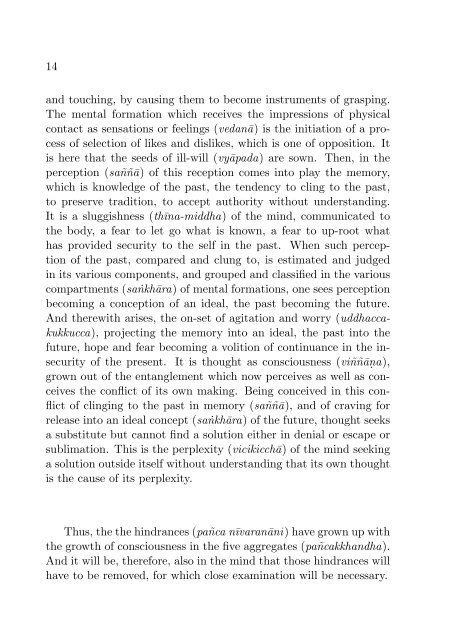Agony and Ecstasy
A comparative study of the five hindrances, together with the five states of concentration or mental absorption.
A comparative study of the five hindrances, together with the five states of concentration or mental absorption.
You also want an ePaper? Increase the reach of your titles
YUMPU automatically turns print PDFs into web optimized ePapers that Google loves.
14<br />
<strong>and</strong> touching, by causing them to become instruments of grasping.<br />
The mental formation which receives the impressions of physical<br />
contact as sensations or feelings (vedanā) is the initiation of a process<br />
of selection of likes <strong>and</strong> dislikes, which is one of opposition. It<br />
is here that the seeds of ill-will (vyāpada) are sown. Then, in the<br />
perception (saññā) of this reception comes into play the memory,<br />
which is knowledge of the past, the tendency to cling to the past,<br />
to preserve tradition, to accept authority without underst<strong>and</strong>ing.<br />
It is a sluggishness (thīna-middha) of the mind, communicated to<br />
the body, a fear to let go what is known, a fear to up-root what<br />
has provided security to the self in the past. When such perception<br />
of the past, compared <strong>and</strong> clung to, is estimated <strong>and</strong> judged<br />
in its various components, <strong>and</strong> grouped <strong>and</strong> classified in the various<br />
compartments (saṅkhāra) of mental formations, one sees perception<br />
becoming a conception of an ideal, the past becoming the future.<br />
And therewith arises, the on-set of agitation <strong>and</strong> worry (uddhaccakukkucca),<br />
projecting the memory into an ideal, the past into the<br />
future, hope <strong>and</strong> fear becoming a volition of continuance in the insecurity<br />
of the present. It is thought as consciousness (viññāṇa),<br />
grown out of the entanglement which now perceives as well as conceives<br />
the conflict of its own making. Being conceived in this conflict<br />
of clinging to the past in memory (saññā), <strong>and</strong> of craving for<br />
release into an ideal concept (saṅkhāra) of the future, thought seeks<br />
a substitute but cannot find a solution either in denial or escape or<br />
sublimation. This is the perplexity (vicikicchā) of the mind seeking<br />
a solution outside itself without underst<strong>and</strong>ing that its own thought<br />
is the cause of its perplexity.<br />
Thus, the the hindrances (pañca nīvaranāni) have grown up with<br />
the growth of consciousness in the five aggregates (pañcakkh<strong>and</strong>ha).<br />
And it will be, therefore, also in the mind that those hindrances will<br />
have to be removed, for which close examination will be necessary.

















